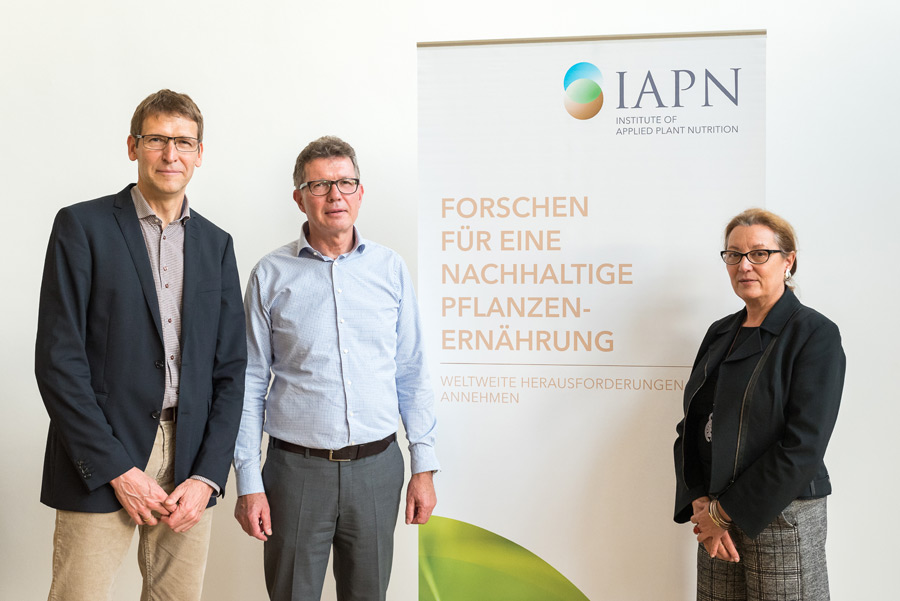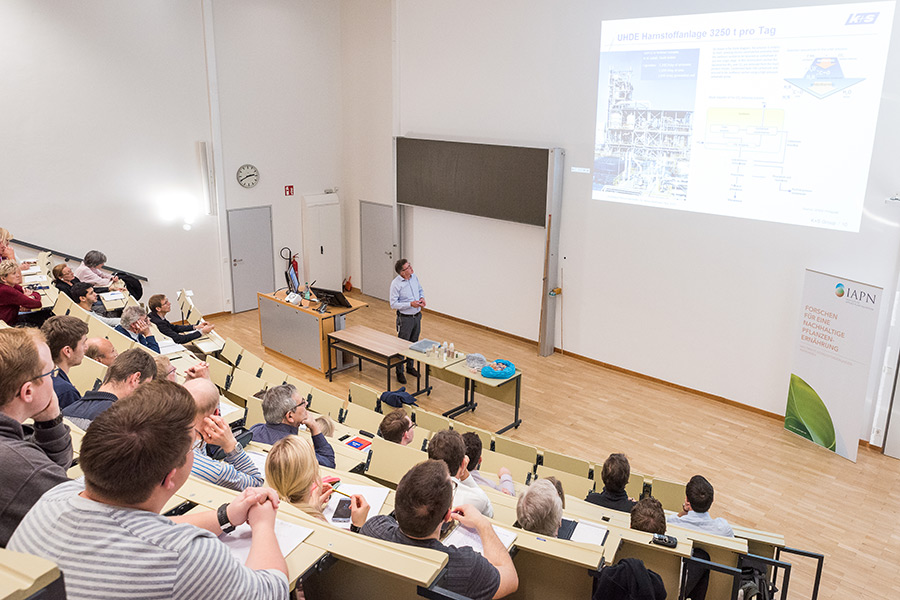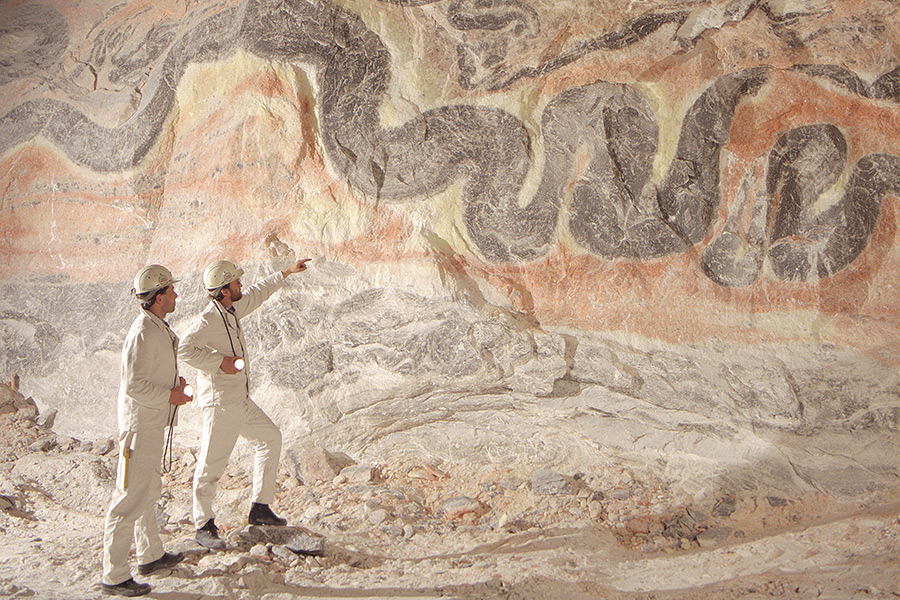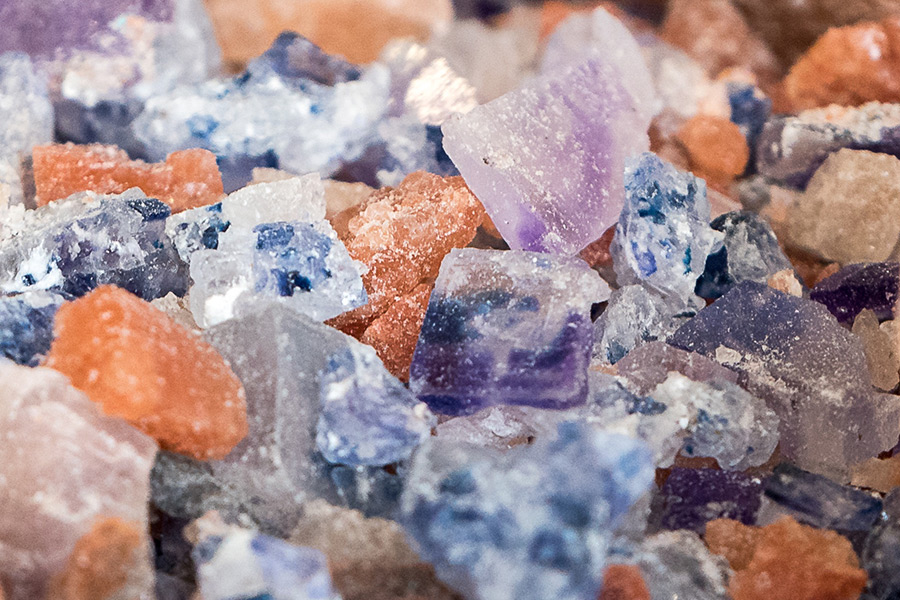IAPN in Dialogue: Prof. Dr. Klaus Dittert, Dr. Ulrich Kleine-Kleffmann and Dr. Beate Deuker (left to right). (Photo: IAPN)
In 2016, approximately 190 million tonnes of nitrogen, phosphorus and potassium were used as plant nutrients worldwide, and the demand is rising. On 14 November, our series of events ‘IAPN in Dialogue’ focussed on just how these fertilizers are manufactured, and on the expectable future availability of natural resources for production. A presentation by Dr. Ulrich Kleine-Kleffmann, Senior Technical Consultant of K+S KALI GmbH provided numerous current data, and was followed by a lively discussion. Prof. Dr. Klaus Dittert moderated the event.
Nitrogen: Extracted from air
With about 105 million tonnes, nitrogen (N) tops the list of plant nutrients used in 2016. The leading nitrogen fertilizer is urea (CO(NH2)2) with a worldwide market share of 58 % (2014) – ahead of ammonium nitrate (NH4NO3) and calcium ammonium nitrate (CaCO3/NH4NO3) – and a nitrogen content of 46 %. One aspect is the production of nitrogen fertilizers; but it is also a great challenge to use the plant-available nitrogen in agriculture without major loss. As Dr. Kleine-Kleffmann said: “The work on how to improve the efficiency of nitrogen fertilization needs to be continued.”
Dr. Kleine-Kleffmann explains the production of urea at one of the world’s largest production plants in Saudi Arabia. Production capacity at this plant is 3,250 tonnes of urea, per day. (Photo: IAPN)
Initially, nitrogen fertilizer production was mainly based on guano and Chile saltpetre (NaNO3). At the beginning of the 20th century, scientists sought chemical processes to convert airborne nitrogen – which to most plants is not directly accessible – into fertilizers. The Haber-Bosch process, which was introduced in 1912, made it possible to combine nitrogen from the air with hydrogen under high pressure and temperature, thereby producing ammonia, which is the basis of most nitrogen fertilizers. With this process the foundation had been laid for large-scale production. Technically refined in the meantime, it is still considered standard practice.
Hyper, super and triple super phosphate
In nature, phosphate most frequently occurs as apatite, with largest deposits in North Africa and the Near East. The most important deposits of apatite are to be found in sedimentary rock, with less frequent occurrence in igneous rock. Apatite is extracted by open-cast mining, and is initially processed mechanically by washing, crushing and sifting. Finely ground, this raw phosphate can already be used as hyper phosphate fertilizer, which is however absorbed only slowly by plants. In order to produce water soluble and rapidly effective phosphate fertilizers, raw phosphate is most frequently reacted with sulfuric acid to form either gypseous super phosphate with a P2O5-content of 16 – 20 %, or triple super phosphate with a P2O5-content of 44 – 48%.
The problem with phosphate fertilizers, especially those extracted from sedimentary deposits, is their cadmium (Cd)-content. Dr. Kleine-Kleffmann explains that the upcoming new European Fertilizer Ordinance will for the first time include EU-relevant threshold values for cadmium. The current discussion focuses on maximum values of 60 mg/kg P2O5, with successive decreases within several years, all the way to 20 mg/kg P2O5.
Potash mining
The most significant deposits of potash salts are situated in Canada, Russia, Germany and in China. Only in Germany do these potassium salt deposits also contain kieserite (MgSO4·H2O).
Mineral deposits containing potassium (K) are typically found at depths of 500 to 1,600 meters. The crude salt is mined by drilling and blasting, and also by cutting. Another option is solution mining: “Water is heated to approximately 70 °C, and is then brought underground where it dissolves potash deposits. The saturated solution is then transported to the surface. Excess water is evaporated, causing the salt to crystallise”, Dr. Ulrich Kleine-Kleffmann describes the mining process. In addition to mineral deposits, potash may also be present in salt solutions such as the Dead Sea in Israel or the Quinghai Lake in China. Potassium from these solutions is extracted by brine extraction and by ‘solar evaporation’.
Typical crude salts to be found in Germany are hard salt and sylvinite, both of which contain a significant amount of sodium. This sodium needs to be removed. Two of the most common industrial treatment processes for fertilizer-quality potassium are flotation and hot dissolution. The ESTA® separation process developed by K+S does not require salt solutions and high energy expenditures for drying the products, as it makes use of the electrostatic charge of the particles for separation.
Carbon footprint
The comparison of carbon footprints generated by the most important N, P and K fertilizers shows that production and application of urea generates the highest emission of CO2, while potassium chloride generates the lowest emission (source: Fertilizers Europe, carbon footprint reference values, 2011). Additionally, in the production of nitrogen fertilizers the synthesis of ammonia by the Haber-Bosch process has its impact: Energy consumption and carbon emissions depend on the hydrogen sources used, with natural gas showing lowest and coal generating highest emissions (information taken from: International Fertilizer Association, IFA, 2009).
How much longer will resources last?
According to Dr. Kleine-Kleffmann, potassium resources will last approximately for 300 more years, but he adds: “If you’ve got adequate technological possibilities for accessing existing resources beyond readily available deposits, potassium supplies should last for several thousand years.” Phosphorus reserves are also estimated to last approximately 300 years. Future options for production for both raw materials may also include raw materials recycling. For nitrogen fertilizers, exploitation of atmospheric nitrogen offers inexhaustible reserves, while natural gas and crude oil are finite. The Haber-Bosch process may in future use hydrogen generated from renewable energies.








